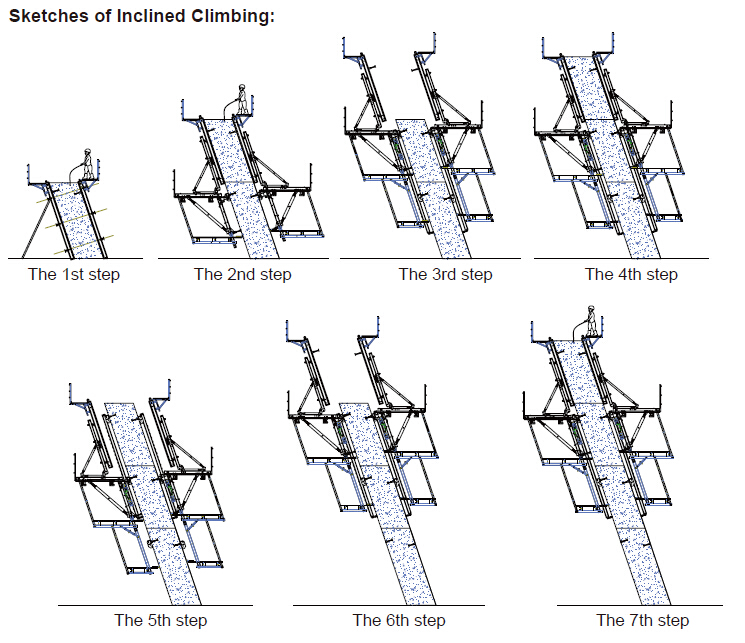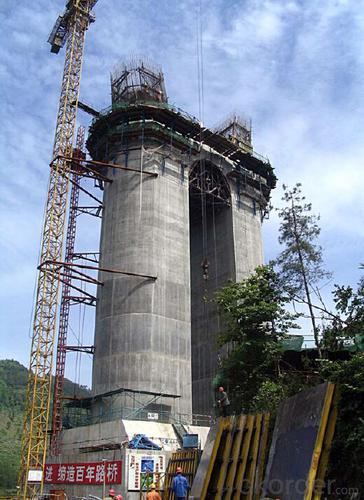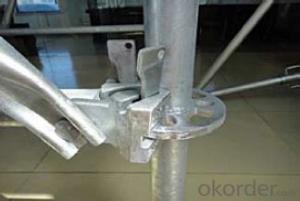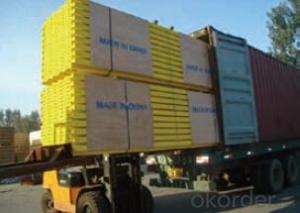Auto Climbing Bracket ACB-100&ACB-50 for formwork and scaffolding system
- Loading Port:
- Tianjin
- Payment Terms:
- TT OR LC
- Min Order Qty:
- 50 m²
- Supply Capability:
- 1000 m²/month
OKorder Service Pledge
OKorder Financial Service
You Might Also Like
Auto-climbing Bracket ACB100 & ACB50
The power of the auto-climbing formwork is the hydraulic system, which includes the oil cylinder
and two commutators. The commutators can control the climbing of climbing rail and the bracket.
The steel rail and the bracket can inter-climbing, so the whole system will climb up steadily.
Cranes are not needed during the construction. It’s easy to operate, highly efficient and safe. It’s
the best choice for the construction of high buildings and bridges.
There are mainly two types of standard auto-climbing brackets, ACB-50 and ACB-100, the figure
means the push power of cylinder with unit of KN.
Characteristics:
◆ Perfect load bearing anchor system
Anchor system is the most important supporting part. The system is made of five parts shown
below. Thereinto, tensile bolt, V-climbing cone and washer can be taken out for reusing after the
concrete pouring finished.There are two kinds of anchor systems,A & B. A is matched with single
anchor shoe and B is matched with double anchor shoe.
◆ Crane-independent
Crane-independent forming, striking and climbing speeds up the work procedures on the
construction site and also makes them independent of each other. This means the planned
sequences can be maintained along with guaranteeing high productivity levels. The crane can
therefore be used for other tasks.
Hydraulic system is mainly made of two commutators,
oil cylinder and power distribution system.The
commutators can control the climbing of climbing rail
and bracket.
◆ High bearing capacity and safe
The stable working platforms are able to carry large loads, e.g. the storage of reinforcing steel
for the next climbing section. Generously-sized working platforms, the well thought-out design for
handling very high wind loads and the patented control function of the climbing mechanism are
some of the special details contained within the comprehensive safety concept.
◆ Platforms adjusted to suit the angle of inclination
The horizontal working areas thus created provide safe and comfortable conditions for
reinforcement work, shuttering and striking, concreting and finishing.
◆ The ACB formwork system can climb not only vertically but also slantways, the largest angle is
18 degrees.
◆ The system can climb up wholly or separately. The climbing process is steady, synchronous
and safe.
◆ The bracket will not fall to the ground until the construction is finished, the field will be saved
and the impacting breakage will be reduced (especially the panel).
◆ The system will furnish omnidirectional platform, the construction organizations don’t need to
set up additional operation platform.
◆ The error of structure construction is small and easy to correct.
◆ The climbing speed is fast, the construction course will be quickened.
◆ The formwork can climb itself and cleaning work can be done in the same situs , the used times
of tower crane will be greatly reduced.

- Q: Can steel formwork be used for both horizontal and vertical applications?
- Yes, steel formwork can be used for both horizontal and vertical applications.
- Q: How does steel formwork affect the speed of construction?
- Steel formwork can greatly enhance the speed of construction due to its numerous advantages. Firstly, steel formwork is highly durable and can withstand repeated use, allowing for multiple pours to be completed without the need for replacement or repair. This eliminates the downtime associated with traditional timber formwork, where the forms often need to be replaced after only a few uses. Additionally, steel formwork is known for its ease of assembly and disassembly. The modular nature of steel formwork allows for quick and efficient installation, reducing the overall construction time. This is particularly beneficial for large-scale projects where time is of the essence. Furthermore, steel formwork offers excellent dimensional accuracy and stability, ensuring precise and uniform construction. This eliminates the need for excessive rework and adjustments, saving both time and resources. Steel formwork is also known for its ability to handle high concrete pressures. This allows for faster pouring and setting of concrete, as there is no need to wait for the formwork to be fully cured before proceeding to the next pour. This results in faster construction cycles and increased productivity. Lastly, steel formwork is compatible with various construction techniques and can be easily adapted to suit different project requirements. It can be used for a wide range of applications, from simple slabs and columns to complex structures, enabling faster construction of diverse building elements. Overall, steel formwork significantly speeds up the construction process by offering durability, ease of use, dimensional accuracy, and compatibility with different construction techniques. Its ability to handle high concrete pressures and its modular nature contribute to faster construction cycles and increased productivity, making it an ideal choice for efficient construction projects.
- Q: What are some of the components of the combined steel template, what role?
- Two, the main equipment1, mechanical equipment, drill, grinding wheel cutting machine, according to the circular machine, electric wrenches and welding equipment, etc..2, the main tool hammer, iron ruler, steel ruler, wrench, wire brush, brush. Drums, crowbar, screwdriver, theodolite, level. Tower ruler.
- Q: Can steel formwork be used for curved or non-standard concrete shapes?
- Yes, steel formwork can be used for curved or non-standard concrete shapes. Steel formwork is flexible and can be easily customized to create various shapes and designs. It provides strength and stability to the concrete structure, making it suitable for complex and unique shapes. Additionally, steel formwork allows for efficient construction processes and can be reused multiple times, making it a cost-effective option for curved or non-standard concrete shapes.
- Q: How does steel formwork contribute to the overall strength and stability of a structure?
- Steel formwork contributes to the overall strength and stability of a structure by providing a rigid and durable framework that supports the weight of concrete during construction. It ensures accurate and precise shaping of concrete, preventing any deformations or cracks. The steel formwork also allows for faster construction as it can be reused multiple times, reducing costs and increasing efficiency. Additionally, its inherent strength and durability enhance the structural integrity of the building, making it more resistant to external forces and increasing its overall stability.
- Q: How does steel formwork handle concrete finishing and curing agents?
- Steel formwork is highly resistant to the chemical agents commonly used in concrete finishing and curing processes. Its durable and non-absorbent surface prevents the concrete from adhering to the formwork, allowing for easy release and smooth finishing of the concrete surface. Additionally, the steel formwork's rigidity and stability ensure that the concrete maintains its desired shape and prevents any deformation during the curing process.
- Q: How does steel formwork handle different concrete finishing techniques?
- Steel formwork is very versatile and can handle various concrete finishing techniques with ease. Its sturdy and rigid structure allows for smooth and precise concrete finishes, regardless of the technique used. Steel formwork ensures that the concrete is held securely in place during the pouring and setting process, allowing for intricate detailing and precise shaping. Whether it's a smooth finish, textured patterns, or decorative imprints, steel formwork provides the necessary support and stability to achieve the desired concrete finishing technique effectively.
- Q: What are the different types of steel formwork systems?
- There are several different types of steel formwork systems commonly used in construction projects. These systems are designed to provide a temporary mold or structure to support the concrete during the pouring and curing process. Here are some of the different types of steel formwork systems: 1. Traditional steel formwork: This is the most common type of steel formwork system, consisting of individual steel panels that are connected together with clamps or pins. The panels can be adjusted to create different shapes and sizes, and they are easy to assemble and dismantle. 2. Modular steel formwork: This system consists of prefabricated steel modules that are connected together to create larger formwork assemblies. The modules are typically lightweight and easy to handle, making them ideal for repetitive use in projects with consistent shapes and sizes. 3. Tunnel formwork: This system is specifically designed for constructing tunnels or underground structures. It consists of steel formwork panels that are connected together to create a continuous, seamless mold. This type of formwork is often used in large-scale infrastructure projects such as subway systems or underground parking garages. 4. Climbing formwork: This system is used for constructing tall structures such as high-rise buildings or towers. It consists of a series of steel formwork panels that are vertically extended as the construction progresses. The panels are attached to a climbing mechanism that allows them to be lifted and repositioned at each level, enabling the continuous construction of the structure. 5. Slip formwork: This system is used for constructing vertical structures such as walls or columns. It consists of a moving formwork that is continuously poured with concrete as it moves upwards. The formwork is supported by steel rods or cables and allows for the rapid construction of tall and straight structures. These are just a few examples of the different types of steel formwork systems available in the market. Each system has its own advantages and applications, and the choice of the right system depends on the specific requirements of the project, such as the size, shape, and complexity of the structure, as well as the desired construction speed and cost-effectiveness.
- Q: Can steel formwork be used for both vertical and inclined concrete placements?
- One can utilize steel formwork for both vertical and inclined concrete placements. Steel formwork is renowned for its exceptional strength and durability, rendering it suitable for a myriad of construction applications. Regardless of whether it is a vertical wall or an inclined surface, steel formwork can provide the necessary support and shape to retain the concrete in place until it solidifies and becomes firm. The flexibility of steel formwork allows for easy adjustment and adaptation when it comes to inclined placements. The formwork panels can be connected and secured at various angles to achieve the desired inclination. This adaptability empowers contractors to construct structures with diverse slopes, such as ramps, stairs, and inclined walls. Moreover, steel formwork can endure the pressure exerted by the fresh concrete during the pouring and curing process. It presents a stable and secure framework that prevents the concrete from collapsing or distorting. This is especially crucial when dealing with inclined placements, as the concrete tends to exert more lateral pressure on the formwork. Furthermore, steel formwork boasts the advantage of being reusable. Unlike traditional timber formwork, steel formwork can be effortlessly dismantled and reassembled for future projects. This not only reduces construction costs but also minimizes waste and environmental impact. In conclusion, steel formwork proves itself to be a versatile solution that can be employed for both vertical and inclined concrete placements. Its strength, durability, and adaptability make it an ideal choice for a wide range of construction projects.
- Q: How does steel formwork affect the overall construction material waste reduction?
- Steel formwork, a construction technique that employs steel panels and frames to create temporary molds or structures for pouring concrete, offers numerous advantages over traditional timber formwork. One notable advantage is its positive effect on reducing overall construction material waste. First and foremost, steel formwork boasts exceptional durability and can be reused multiple times, unlike timber formwork that often requires replacement due to wear and tear after only a few uses. Consequently, steel formwork greatly diminishes the amount of material waste generated during construction, as there is minimal need for regular replacements. Furthermore, steel formwork exhibits greater precision and accuracy compared to timber formwork, resulting in less concrete waste. The precise measurements and tight joints of steel formwork ensure the correct pouring and setting of concrete, minimizing the need for additional material to fill gaps or rectify errors. This reduction in material waste is achieved by minimizing the amount of concrete wasted during the construction process. In addition, steel formwork is highly adaptable and adjustable to various shapes and sizes, allowing for efficient and flexible use in diverse construction projects. Its versatility permits reuse for different structures or modification to meet changing requirements. This adaptability further reduces material waste, as the same formwork can be utilized for multiple projects or repurposed as needed. Moreover, steel formwork is renowned for its high strength and load-bearing capacity, enabling it to withstand substantial concrete pressure without deformation or damage. This strength allows for the construction of taller and more complex structures using steel formwork, reducing the need for additional materials such as support beams or columns. By eliminating the requirement for these extra materials, steel formwork contributes significantly to the overall reduction of construction material waste. In conclusion, steel formwork positively impacts the reduction of construction material waste through its durability, precision, adaptability, and strength. By minimizing the need for regular replacements, reducing concrete waste, allowing for reuse and adaptability, and eliminating the necessity for additional materials, steel formwork plays a vital role in promoting sustainable construction practices and reducing environmental impact.
Send your message to us
Auto Climbing Bracket ACB-100&ACB-50 for formwork and scaffolding system
- Loading Port:
- Tianjin
- Payment Terms:
- TT OR LC
- Min Order Qty:
- 50 m²
- Supply Capability:
- 1000 m²/month
OKorder Service Pledge
OKorder Financial Service
Similar products
Hot products
Hot Searches


















